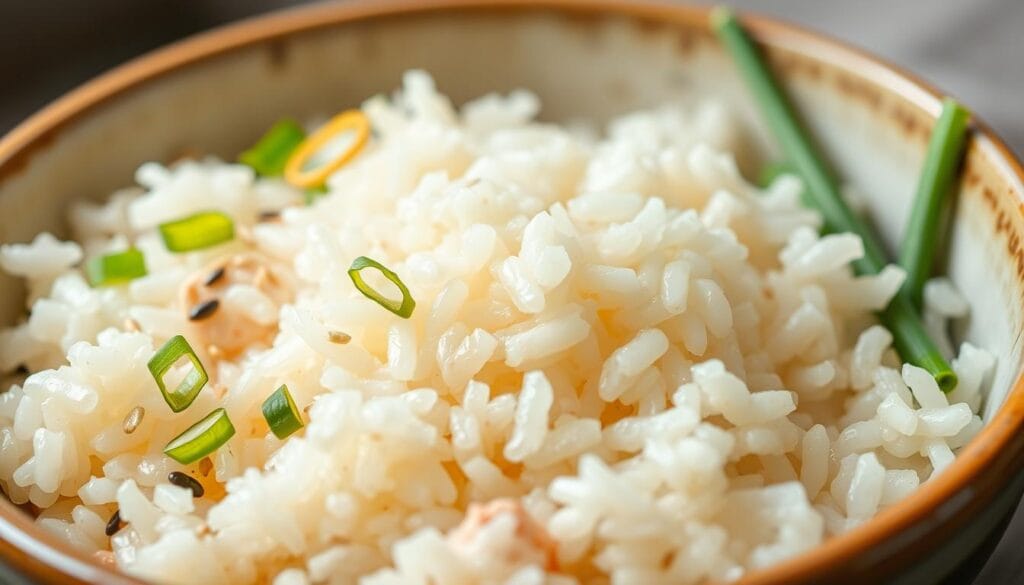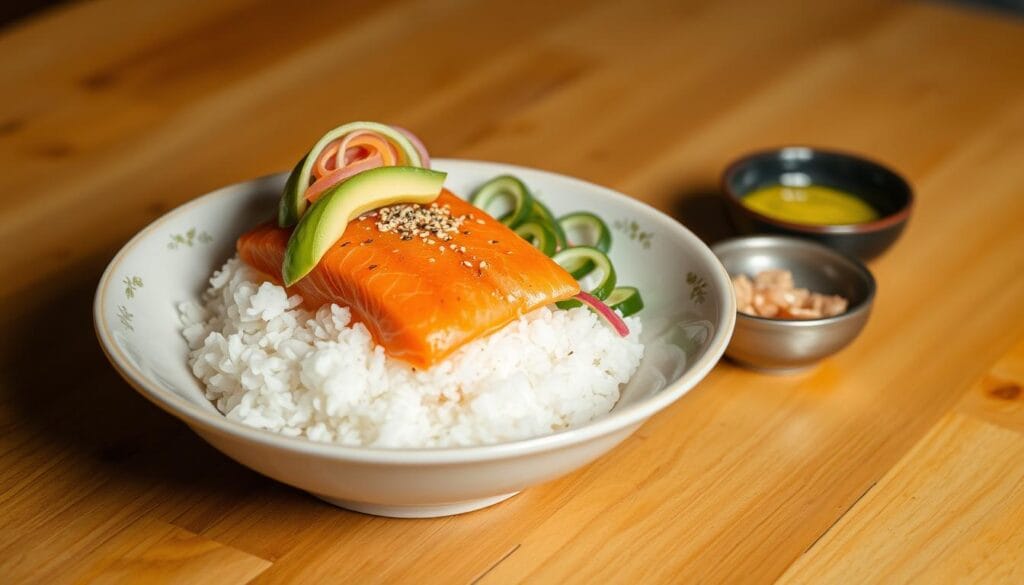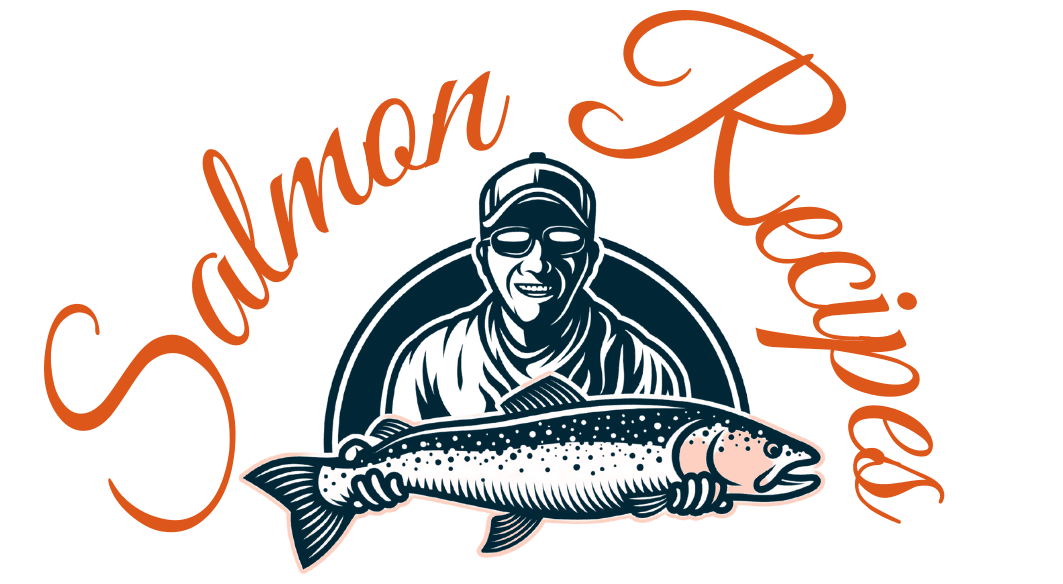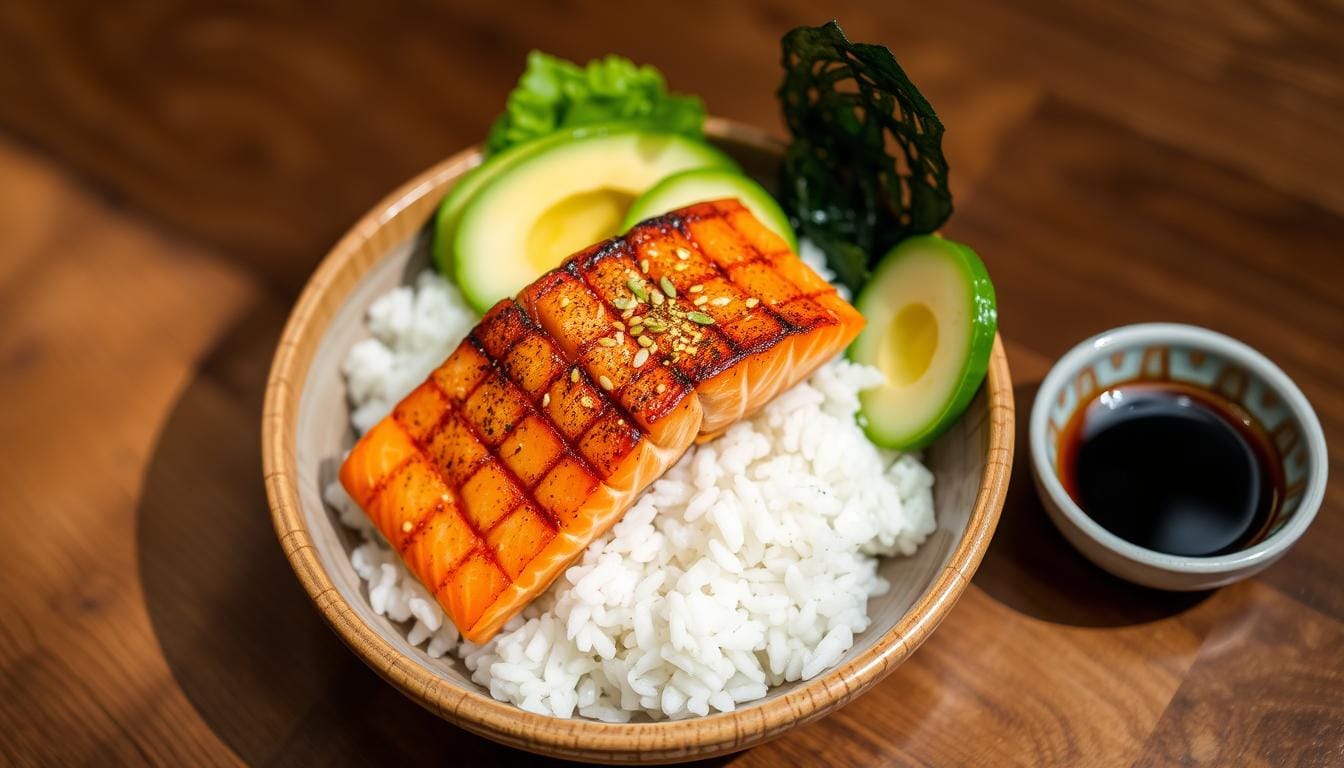Table of Contents
The smell of salmon cooking in my kitchen reminds me of family dinners. These meals were all about health and taste. A healthy salmon bowl is more than food; it’s a special experience that turns simple things into something amazing.
Salmon rice bowls are a great choice for quick, healthy dinners. They’re full of protein, healthy fats, and tasty flavors. You can make them your own, no matter what you like.
Whether you’re new to cooking or have been doing it for years, salmon rice bowls are easy to make. You can have a delicious, healthy meal ready in just 15 minutes.
In this guide, we’ll cover everything you need to know about making the best salmon rice bowl. We’ll talk about choosing the right ingredients and cooking techniques. Get ready to make your weeknight dinners healthier and more delicious.
Introduction to Salmon Rice Bowls
Salmon rice bowls are a hit in the food world. They mix the taste of salmon with many ingredients. This makes for a healthy and tasty meal.
Origins and Cultural Significance
The salmon recipe comes from Asian traditions. It started in Japan and Hawaii and now is loved worldwide. It combines fresh fish with rice, showing a long history of healthy eating.
- Traditional Japanese poke bowls inspired modern salmon rice bowls
- Hawaiian cuisine significantly influenced the dish’s development
- Rice as a foundational ingredient in Asian cooking
Rising Popularity in Modern Cuisine
Today, people love salmon rice bowls for their ease and health benefits. They are great for busy people who want a nutritious meal.
“A salmon rice bowl is more than a meal – it’s a culinary journey in a single dish.” – Culinary Expert
Health Benefits Overview
| Nutritional Component | Health Benefit |
|---|---|
| Omega-3 Fatty Acids | Supports heart health and reduces inflammation |
| Protein | Muscle maintenance and growth |
| Essential Minerals | Boosts immune system and energy levels |
These bowls use about 2 lbs of salmon filets. They are full of omega-3s, protein, and minerals. This makes them a great choice for those who want a healthy meal.
Essential Components of a Perfect Salmon Rice Bowl
Making delicious homemade rice bowls is all about the key ingredients. Your salmon rice bowl is more than food—it’s a work of art. It combines nutrition, flavor, and looks.
- Base Rice: Choose Japanese short-grain rice for authentic texture and flavor
- Protein: Fresh, high-quality salmon as the star ingredient
- Rice Bowl Toppings: Fresh vegetables and garnishes for added nutrition
- Sauces: Flavor-enhancing seasonings like soy sauce and sesame oil
When picking rice bowl toppings, think about contrasting textures and flavors. Avocado adds creaminess, cucumber brings crispness, and pickled vegetables add tangy notes.
“A perfect salmon rice bowl is a symphony of flavors and textures” – Culinary Experts
Nutritional insights show that a salmon rice bowl is very healthy:
- 52% daily protein value
- 29% daily fat value
- 18% daily carbohydrate value
Mastering these key components will help you make rice bowls that are unforgettable.
Selecting Quality Salmon for Your Bowl
Making a great healthy salmon bowl begins with picking the right fish. The quality of salmon greatly affects your dish. It can turn a simple meal into a memorable one.
It’s important to know your salmon options. Not all salmon is the same. Choosing wisely can make your dish stand out.
Wild-Caught vs Farm-Raised Salmon
- Wild-Caught Salmon:
- More nutritionally dense
- Stronger flavor profile
- Lower in total fat content
- Farm-Raised Salmon:
- More consistently available
- Generally less expensive
- Higher fat content
Salmon Varieties to Know
| Salmon Type | Flavor Profile | Best Cooking Method |
|---|---|---|
| King Salmon | Rich, buttery | Grilling, baking |
| Sockeye Salmon | Robust, intense | Searing, roasting |
| Atlantic Salmon | Mild, delicate | Pan-searing, poaching |
Salmon Storage and Handling Tips
Keeping salmon fresh is crucial. Store it in the fridge at 40°F or below. Use it within 1-2 days. For longer storage, freeze it right away and eat within 3 months.
“Fresh salmon should have a mild ocean scent and firm, elastic flesh – these are signs of peak quality for your seafood recipes.”
When buying salmon, look for bright, clear flesh. Avoid brown or yellow spots. Sushi-grade salmon is best for raw or lightly cooked dishes.
Mastering the Rice Base

Creating the perfect rice base is key for tasty homemade rice bowls. Start with the right rice and learn cooking techniques. These steps turn a simple grain into a delicious base.
Japanese short-grain rice is the top pick for salmon rice bowls. It’s sticky and soaks up flavors well. The secret to great rice is in how you prepare it.
Rice Selection and Preparation
- Japanese short-grain rice: Best for traditional bowls
- Jasmine rice: Light and fragrant alternative
- Brown rice: Nutrient-dense option
Rinsing rice is a must-do step many miss. Wash your rice well until the water is clear. This removes excess starch for fluffy, separate grains.
Ideal Cooking Ratios
| Rice Type | Water Ratio | Cooking Time |
|---|---|---|
| Short-grain Rice | 1:1.5 (rice:water) | 18-20 minutes |
| Jasmine Rice | 1:1.75 (rice:water) | 15-18 minutes |
“Perfect rice is the canvas upon which a great rice bowl is painted.” – Culinary Wisdom
Pro tip for easy dinner ideas: Get a rice cooker for perfect results. Your homemade rice bowls will love you for it!
Try different rice types to find your favorite. Each variety adds its own texture and taste to your salmon rice bowl. This makes every meal a new adventure.
Preparing the Perfect Salmon
Making a tasty salmon recipe needs attention to detail. Your quick and delicious meal depends on the right cooking techniques. To make a perfect salmon rice bowl, learn how to cook the fish well.
Getting good at salmon preparation means following a few key steps. These steps ensure your salmon is both tasty and safe to eat. Professional chefs say these methods can make your salmon rice bowl stand out.
Marination Magic
Marinating makes your salmon taste amazing. Try these magic marinades:
- Soy sauce and honey blend
- Garlic and rice vinegar mix
- Sriracha-infused marinade
Optimal Cooking Methods
Choosing the right cooking method can change your salmon’s taste and texture. Here are some top methods:
| Cooking Method | Temperature | Cooking Time |
|---|---|---|
| Baking | 400°F | 8-10 minutes |
| Pan-Searing | Medium-High | 3-4 minutes per side |
| Grilling | Medium | 4-6 minutes |
Temperature Guidelines
Keeping your salmon safe to eat is key. Make sure it reaches an internal temperature of 145°F. Use a meat thermometer to check it’s done right.
“The secret to a perfect salmon rice bowl is respecting the fish’s delicate nature while maximizing its incredible flavor.” – Culinary Expert
Pro tip: Let your salmon rest for 2-3 minutes after cooking. This helps keep it moist and tender. This simple trick can make your salmon recipe amazing.
Creating Flavorful Sauce Combinations
Sauces are key to making ordinary rice bowls special. They bring your Asian-inspired meal to life. The right sauce mix can balance flavors and make the dish stand out.
When making sauce combinations for your salmon rice bowl, think about these flavors:
- Sweet and tangy like teriyaki
- Spicy options such as sriracha mayo
- Classic Asian soy and ginger blends
Making the perfect sauce is about finding flavor balance. A good sauce should enhance your salmon without hiding its taste. Here are some easy homemade sauce ideas:
- Spicy Mayo: Mix 1/2 cup mayo with 1/3 cup sriracha
- Ginger Soy Glaze: Blend soy sauce, fresh ginger, and a bit of honey
- Sesame Citrus Drizzle: Combine sesame oil with fresh lime juice
“A great sauce can turn a simple salmon rice bowl into a top-notch meal.”
Try out different sauces to find your favorite. Your homemade rice bowls are a blank canvas for creativity. You can adjust flavors to match your taste.
Fresh Vegetables and Toppings Selection
Making a great salmon rice bowl is more than just cooking fish. The right toppings can make your meal amazing. Choose fresh, colorful veggies and garnishes to add nutrition and fun.
Seasonal Vegetable Options
Your salmon bowl should have a variety of colorful veggies. Here are some seasonal picks:
- Summer: Juicy tomatoes, crisp cucumbers, sweet bell peppers
- Fall: Roasted butternut squash, pickled radishes, sautéed kale
- Spring: Asparagus, green onions, fresh peas
- Winter: Roasted Brussels sprouts, carrots, winter squash
Texture-Adding Elements
Add different textures to your bowl to match the salmon’s richness:
- Crunchy: Toasted sesame seeds, crispy nori strips
- Creamy: Sliced avocado, whipped goat cheese
- Crisp: Pickled vegetables, radish slices
Garnishing Ideas
Finish your salmon bowl with these touches:
| Garnish | Flavor Profile | Nutritional Boost |
|---|---|---|
| Green Onions | Sharp, Fresh | Vitamin K |
| Furikake | Umami, Savory | Minerals |
| Fresh Herbs | Bright, Aromatic | Antioxidants |
| Microgreens | Delicate | Concentrated Nutrients |
“The right toppings can turn a good salmon rice bowl into an extraordinary culinary experience.”
It’s all about balance: flavors, textures, and nutrition. Try different toppings to find your favorite salmon bowl.
Step-by-Step Assembly Guide

Making a simple yet impressive dinner is easy. This quick meal can be put together in a few steps. It turns basic ingredients into a stunning salmon rice bowl.
Here’s how to build the perfect bowl:
- Rice Foundation: Begin with ½ cup of fluffy white rice. Freshly cooked rice gives the best texture.
- Salmon Placement: Place a 6-ounce salmon fillet on the rice. Make sure it’s in the middle.
- Vegetable Layer: Surround the salmon with colorful veggies. Try these:
- Sliced cucumber
- Pickled red onions
- Sliced avocado
- Edamame
- Garnish and Finish: Top with sesame seeds, green onions, and a lime squeeze.
Tip: Add your favorite sauce for extra flavor. A mix of soy sauce, honey, and sriracha is great.
“The art of a great rice bowl is in the balance of flavors and textures” – Professional Chef
Follow these steps to make a meal that looks like it’s from a fancy restaurant. It’s quick and perfect for a busy weeknight.
Nutritional Benefits and Dietary Considerations
Making a healthy salmon bowl is more than just delicious—it’s a nutritional powerhouse. Salmon is packed with essential nutrients. It offers health benefits that make these recipes great for those who care about wellness.
The nutritional profile of a salmon rice bowl is impressive. A typical serving gives you:
- High-quality protein (about 17 grams per 3-ounce serving)
- Abundant omega-3 fatty acids (1.9 grams per serving)
- Essential vitamins and minerals
| Nutrient | Amount per 100g Serving |
|---|---|
| Calories | 232 kcal |
| Protein | 25.2g |
| Fat | 14.6g |
| Vitamin D | 7.3 mcg |
| Selenium | 20 mcg |
Salmon’s health benefits go beyond basic nutrition. Omega-3 fatty acids in salmon support brain health. They may reduce age-related cognitive decline. Salmon also has astaxanthin, a powerful antioxidant. It may lower heart disease risks by improving cholesterol levels.
Eating salmon twice a week can contribute to overall wellness and provide significant nutritional benefits.
For those with specific dietary needs, salmon rice bowls can be easily customized. Whether you’re following a gluten-free, low-carb, or high-protein diet, these versatile bowls can be adapted to meet your nutritional goals.
Remember to cook salmon safely. Prepare it to an internal temperature of 145°F (63°C). This ensures both flavor and nutritional value in your healthy salmon bowl.
Time-Saving Tips and Meal Prep Strategies
Making easy dinner ideas doesn’t have to be hard. A simple meal like a salmon rice bowl can be made easier with smart prep. This saves time and cuts down on cooking stress.
Meal prep light lets you cook many meals at once. This way, you can make nutritious meals without spending hours cooking.
Make-Ahead Components
Here are some ways to make meal prep easier:
- Roast vegetables in advance (40-50 minutes at 400-425°F)
- Pre-cook salmon (10-15 minutes at 400°F)
- Prepare rice batch during kitchen downtime
- Store prepped proteins in refrigerator for 3-4 days
Storage Solutions
Right storage keeps your meal fresh and tasty:
- Use airtight containers for each component
- Separate wet and dry ingredients
- Store salmon and rice separately
- Refrigerate components for up to 3 days
Reheating Instructions
Here’s how to reheat your salmon rice bowl:
- Microwave assembled bowl for 2 minutes
- Add a splash of water to maintain moisture
- Stir midway through reheating
- Check internal temperature reaches 165°F
Pro tip: Batch cooking during natural kitchen downtime can transform your meal preparation strategy!
With these strategies, you’ll master easy dinner ideas that are both convenient and delicious.
Conclusion
Your journey to making tasty homemade rice bowls has come to an end. The salmon rice bowl is more than food; it’s a mix of health, taste, and creativity. You now know how to make dishes that rival those from restaurants, right in your kitchen.
Every salmon rice bowl is a chance to try new flavors and ingredients. You’ve learned how to pick the best salmon and season it just right. This way, you can make a meal that’s both colorful and fulfilling. Plus, you can change up the recipe to fit your diet and what’s in season.
Don’t worry if your first salmon rice bowl isn’t perfect. Every try you make will make you better at cooking. Try out different veggies, unique marinades, and find your own style. The fun of cooking is learning and sharing great meals with others.
Your cooking adventure is just starting. Keep trying new things, tasting, and making salmon rice bowls that show off your taste and health goals. Enjoy every step, relish each bite, and most of all, have fun cooking.
FAQ
What makes salmon rice bowls a healthy meal option?
Salmon rice bowls are full of good stuff. They have protein from salmon, omega-3s, carbs from rice, and vitamins from veggies. They’re good for your heart, give you energy, and are full of nutrients.
How do I choose the best salmon for my rice bowl?
Pick fresh, high-quality salmon. Wild-caught King or Sockeye is best for taste and health. Make sure it’s firm, bright, and smells good. Buy from a trusted fishmonger and keep it fresh.
Can I prepare salmon rice bowls in advance?
Yes! Cook rice, marinate salmon, and chop veggies ahead. Store them in airtight containers in the fridge. You can prep 2-3 days early, perfect for busy people.
What are some good sauce options for salmon rice bowls?
Try teriyaki, ponzu, or spicy mayo for a taste of Asia. Or make your own with soy sauce, rice vinegar, sesame oil, and sriracha. Mix sweet, salty, tangy, and spicy for the best flavor.
Are salmon rice bowls suitable for special diets?
Yes, they’re very flexible. For gluten-free, use tamari instead of soy sauce. For low-carb, try cauliflower rice. They’re great for many diets.
What are the best vegetables to include in a salmon rice bowl?
Mix raw and cooked veggies for texture and nutrition. Cucumber, avocado, edamame, pickled carrots, roasted Brussels sprouts, and seaweed are great. Use seasonal veggies to keep it interesting.
How long should I cook salmon for my rice bowl?
Cooking time varies by method and salmon thickness. Bake at 400°F for 12-15 minutes, pan-sear for 3-4 minutes each side, or grill for 4-5 minutes. It’s done when it’s 145°F and flakes easily.
Can I use frozen salmon for my rice bowl?
Yes, frozen salmon works well. Thaw it in the fridge, pat dry, and cook when it’s room temperature. Good frozen salmon can taste as fresh as the real thing.
What type of rice works best for salmon rice bowls?
Japanese short-grain rice is best for its sticky texture and flavor absorption. Brown rice adds fiber, and cauliflower rice is low-carb. Just cook and season it right.
How can I make my salmon rice bowl more affordable?
Opt for farm-raised Atlantic salmon, buy in bulk, and watch for sales. Use seasonal veggies, make your own, and consider canned salmon when fresh is pricey.

